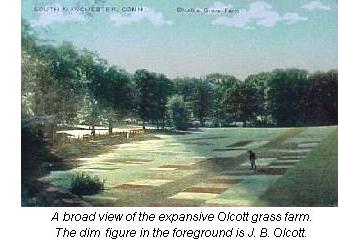
REPRINTS

 His turf gardens were world famous ... certainly at one time no less than 1500 distinct varieties.
His turf gardens were world famous ... certainly at one time no less than 1500 distinct varieties.
... not extensive, being contained in a tract of about one acre, nearly opposite the Olcott Homestead.
The grasses came from almost every corner of the world. He developed his varieties from turf - not from seeds. He
toured continental Europe collecting a turf here and a turf there. He campaigned to spread the education on grasses.
An illustration of his philosophy: "Last year a single sward, of one of these Cinderella grasses (waiting for the farm
princes of Connecticut to put its slippers on for travel) was cut in inch pieces and planted in a rich sandy garden. In
less than twelve months, it had increased a hundred fold in surface, made a show of two tons of hay per acre, yielded ten
sheaves of seed hay per acre, three feet high, with more than eight quarts of merchantable seed. Seeds and sods of this
grass have been distributed to forty-two experiment stations. It was found in an old and neglected pasture, and is probably
a survivant of the times when men and women knew what makes solid turf better than we do." This showed what was right
beneath the noses of those who did not know the value of the variety of grass and sent money afar for rare seeds.
 O.C. remembers Walter Olcott very well. He was probably the best authority on grass in his time. He had quite a large area
of land divided into square plots of kinds of grass. He obtained grasses from foreigh lands and, by cross-breeding and
selection, developed special kinds for special uses. One, it was claimed, would thrive best in paths subjected to heavy
pedestrian traffic. Walter's consultation and advice were in demand far and wide. He was called in on Prospect Park in
Brooklyn and Central Park in New York among many others.
O.C. remembers Walter Olcott very well. He was probably the best authority on grass in his time. He had quite a large area
of land divided into square plots of kinds of grass. He obtained grasses from foreigh lands and, by cross-breeding and
selection, developed special kinds for special uses. One, it was claimed, would thrive best in paths subjected to heavy
pedestrian traffic. Walter's consultation and advice were in demand far and wide. He was called in on Prospect Park in
Brooklyn and Central Park in New York among many others.
The Hartford Park Department was having trouble in Bushnell Park and called for Walter. He was down on all fours
pulling up grass and examining the roots with a magnifying glass when a policeman touched him on the shoulder and said,
"Can't you see that sign, 'Keep off the Grass'?" Walter replied, "Yes, I see the sign, but where's the grass?"
In warm weather, Walter always dressed in a light linen suit with knickers and invariably had a sprig of white pine in
his lapel.
Ed. Note: O.C. remembered him as Walter instead of Luther, but his facts are accurate beyond that.
J.B. Olcott was appointed to a committee of three to investigate and report on an offer of land and money from Augustus
and Charles Storrs to establish a school of agriculture in Storrs, CT. The report from the committee was favorable, and the
1880 offer was accepted in 1881 by the General Assembly, and the Storrs Agricultural School was established.
The organization of the school was entrusted to T. S. Gold, J. B. Olcott, and S. W. Johnson. In 1881, Mr. Olcott
became a member of the first Board of Trustees of Storrs Agricultural School.
Ed. Note: Upon the opening of the Storrs Agricultural School, Olcott wrote a description of the events to
the Hartford Daily Courant, which is available in this website. To read the article, please click
Courant Letter.
We were excited to discover that the first true lawn � manicured, mowed, and composed almost entirely of a uniform
turf grass � was raised only a few miles from our home in the Last Green Valley.
James B. Olcott, a farmer, botanist, co-founder and trustee of the Storrs Agricultural School (now the University of
Connecticut), and long-time adjunct at the Connecticut Agricultural Experiment Station, developed the first �turf garden�
in the United States at his home in Manchester.
Soon, Olcott�s garden attracted the attention of golf enthusiasts, including the golf writer C.V. Piper. According to
an article Piper wrote in the first issue of �Bulletin of the Green Section of the United States Golf Association� in 1921,
�as early as 1885 ... Olcott conceived the idea that �greenswards� could be developed of�fine quality.� The botanist
traveled the world searching for different strains of grass to cross-pollinate in order to create the perfect lawn.
�When I first saw the garden in 1910,� Piper recalled, �the great majority of the (golf) plots consisted of strains of
red fescue,� an inferior grass. Olcott�s turf, Piper quickly realized, was far superior. In the 1910�s, Olcott sold his
turf garden to Frederick W. Taylor, the efficiency expert, who moved it to his estate near Philadelphia for use as a golf
course.
Following in Olcott�s footsteps, and at the urging of the United States Golf Association, scientists at other states�
colleges and experiment stations and at the U.S. Department of Agriculture�s experimental farms in Virginia and Maryland
developed new strains of turf grass that would thrive not only in the cool, rain-drenched climate of the Last Green Valley
but in the torrid south and arid west as well.

